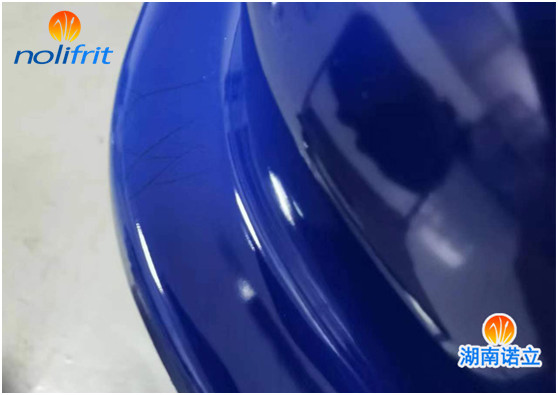Nolifrit Solves Enamel Edge Cracks For Customer
There are obvious cracks on the edge of the enamel product, but the cause cannot be found. What should I do?
In August, a customer contacted us due to obvious transverse cracks on the edge of the product. After the customer sprayed the enamel products with colored enamel, there were obvious cracks at the outer R corner. After receiving the defect pictures and detailed data of the enamel products, Nolifrit technical team immediately gave the reason with rich experience: the powder enamel layer at the R corner is too thick and the ground coat cannot be burned through. As long as we know the reason, the follow-up problem is easy to solve.

In order to help the majority of enamel factories solve the problem of cracks, we sorted out the causes of cracks on the edge of enamel for you, so that you can find and analyze them easily. It is recommended to collect them.
Edge cracks can be divided into four types: straight cracks, transverse cracks, circular cracks and plastic crushing.
Straight cracking refers to the vertical bursting of the edge of the porcelain surface, and the edge of the iron billet is low in strength and easy to deform, such as enamel products with flat edges and deep shapes. To improve the shape of the edge and increase the mechanical strength, the thickness of the thin steel plate can be increased if necessary.
Transverse cracking refers to the bursting of the porcelain layer in a horizontal linear or zigzag shape. There are many reasons, such as the side enamel is too thick or the ground coat is not fired enough (the above case is the reason), the side enamel paste is stored for too long; Insufficient; the mechanical strength of the edge enamel is low, and the edge has been bumped, pryed, and the ground coat has boiled. In this case, pay attention to the piping enamel paste should be used with the grinding, not stored for too long, and not too thick when piping; clean the edges, pay attention to the situation of powder accumulation in the edge gaps, the ground coat is burnt through, and can be adjusted if necessary The formula of the edge enamel enhances the mechanical strength.
Circular cracking refers to the bursting of the porcelain layer in a ring shape. It may be that the piping enamel slurry is mixed with garbage or the edge and ground coat has bubbles, and the firing is insufficient.
Plastic pressure injury refers to the rupture of the upper edge of the edge of the enamel product or the porcelain layer of the mouth, which is caused by cold enough plastic surgery or excessive force. It is necessary for the staff to master the shaping temperature, the shaping tools should be preheated in advance, and the force should be even and not excessive during operation.